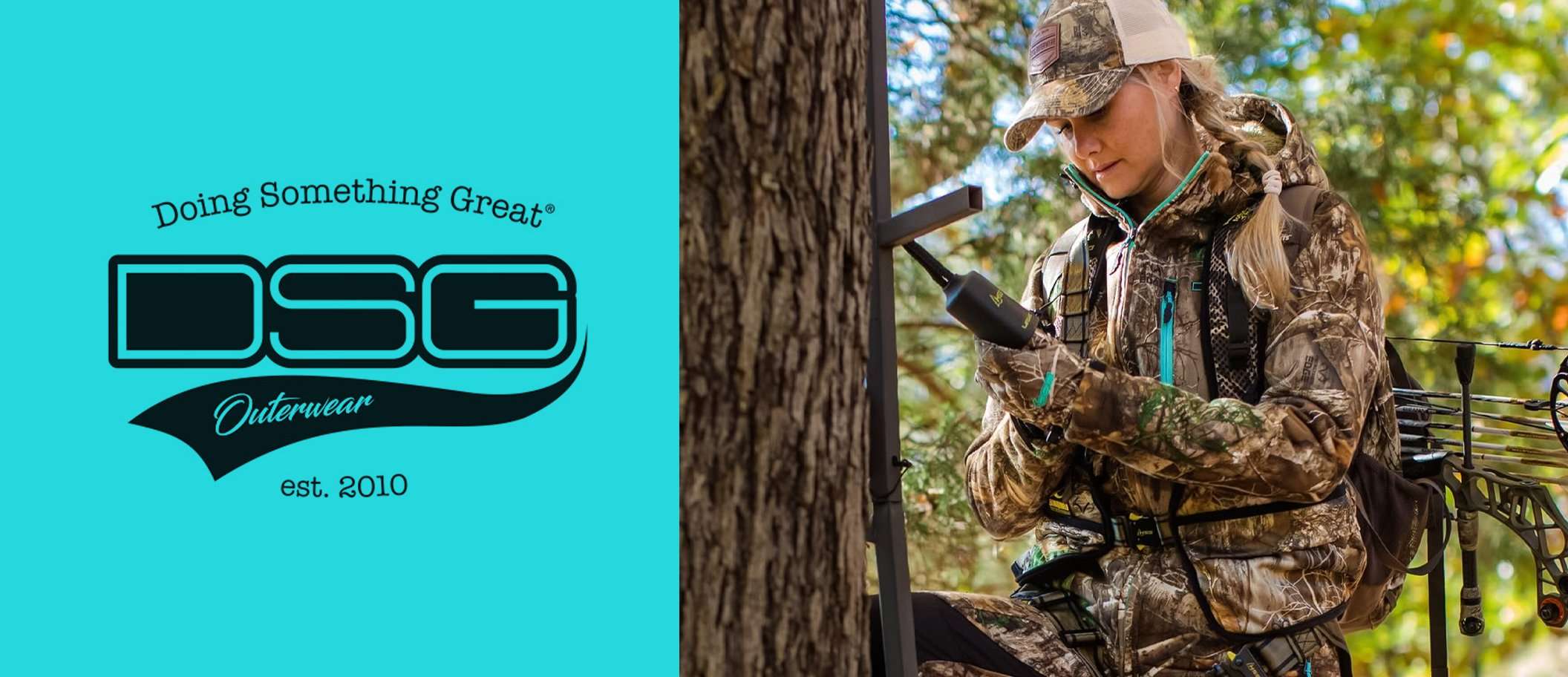A Tennessee River catfish guide shares his secrets for a light-tackle drift using plain, store-bought chicken
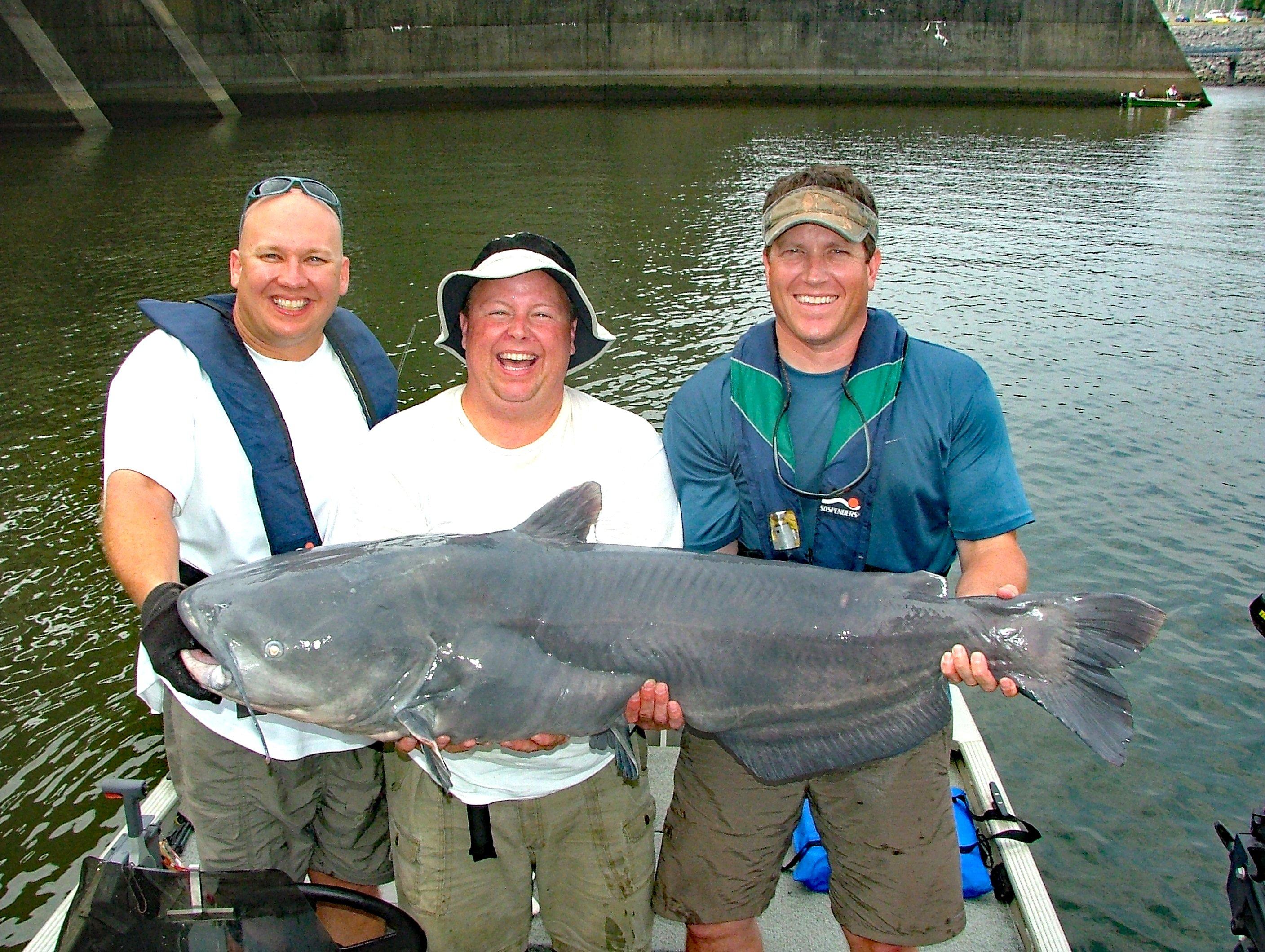
Showing off a “3-man catfish,” Terry Uhrine (center) claimed the National Freshwater Fishing Hall of Fame 10 lb. test line class record (Catch & Release) fishing with Capt. Richard Simms, using chicken breast as bait. Uhrine had to have help from his friends, Gary Hatchcock (left) and Ted Boozer (right) to show off his 53-inch blue for the camera. (Photo: Capt. Richard Simms)
It was blazing hot at 2 pm. The temperature was nearing 95 degrees, no breeze and a heat index over 100. The Tennessee River was glassy smooth reflecting just a few puffy white clouds overhead.
Suddenly, out of the corner of my eye I saw my client’s 7-foot spinning rod with a light action tip literally whipsaw toward the water. I probably imagined it, but I could swear it cracked like bullwhip.
He grunted and I said, "Dang! I don't know if that one is big, but it sure hit big!"
We were using one of my favorite catfishing techniques. My guide partners and I call it our "light tackle drift." Our rods are standard 6- to 7-foot spinning rods, usually medium action, with a standard spinning reel loaded with monofilament as light as 8-pound test up to 20-pound test braided line. It is the same equipment the majority of fishermen might use for bass or even bluegill.
However, the most important part of the “light tackle drift” arsenal is the bait – plain old, run-of-the-mill, unadulterated, unaltered, non-flavored chicken breast. That’s right – chicken breast that was likely resting comfortably in the cooler of my favorite neighborhood grocery store just a short time before.
I have been catfishing since the 1990s and I have been a licensed, professional catfish guide since 2006. I routinely tell folks that, “if it wasn’t for chicken breast, I probably couldn’t guide for catfish.”
Hardcore catfishermen know if you want fresh-cut bait to lure catfish, it can sometimes take longer to catch the bait than it does the catfish. Some people might live where there is a ready, year-round supply of skipjack, gizzard shad, or even bluegill to use for cut or live bait. But those places are rare and even if you have them, you still need hours to keep a good supply of fresh bait on hand. During peak season, when I might be running guided trips five or six days a week, keeping an adequate supply of fresh bait would be physically impossible. Catching enough bait isn’t guaranteed, and it eats into a client’s catfishing time.
Don’t Miss: How to Freeze and Store Fish for Maximum Flavor

Capt. Simms prefers a 3/0 Kahle hook when he is using his chicken drift technique. The Kahle hooks, with a less-exposed hook point, are much less likely to snag the bottom when drifting. (Photo: Capt. Richard Simms)
ENTER CHICKEN BREAST!
Does chicken breast really work?
One of my clients holds the catch-and-release world record for the biggest blue cat taken on 10-pound test line from the National Freshwater Fishing Hall of Fame. And yes, that fish ate a chunk of chicken breast.
I introduced one of my catfish guide partners, Capt. Aaron Massey, to the light tackle chicken drift a year or two ago. Capt. Massey has been a hardcore catfisherman many years, but he had always “fished big,” often targeting trophy cats. And, of course, clients love catching monster blues and flatheads from the Tennessee River. But some clients don’t like playing the waiting game. They just want bent rods and Capt. Massey was amazed at how effective the chicken drift worked.
“I'll be the first to admit I thought drifting chicken down the river with 10-20 lb. line was kind of silly,” he said. “I'll be the first to tell you I was absolutely wrong. It's a blast and a great way to get on action. If the conditions are right and you're drifting the right area, it's common to have doubles and triples drifting chicken on light tackle.
“I remember the very first evening I attempted a drift. My first drift in the tailrace below the dam, I got bit pretty quick and landed a 20-plus-pound blue. ‘Awesome,’ I thought. ‘That didn't take long!’ I fired the motor and went back up toward the dam to try it again. I got 4 poles out then; “Bam!,” one was singing drag like it hung the bottom. After drifting a quarter-mile downriver and some insane drag runs, the bottom ended up being a blue cat pushing the 50-pound mark. It was an, “Ah ha,’ moment that I’ll always remember.”
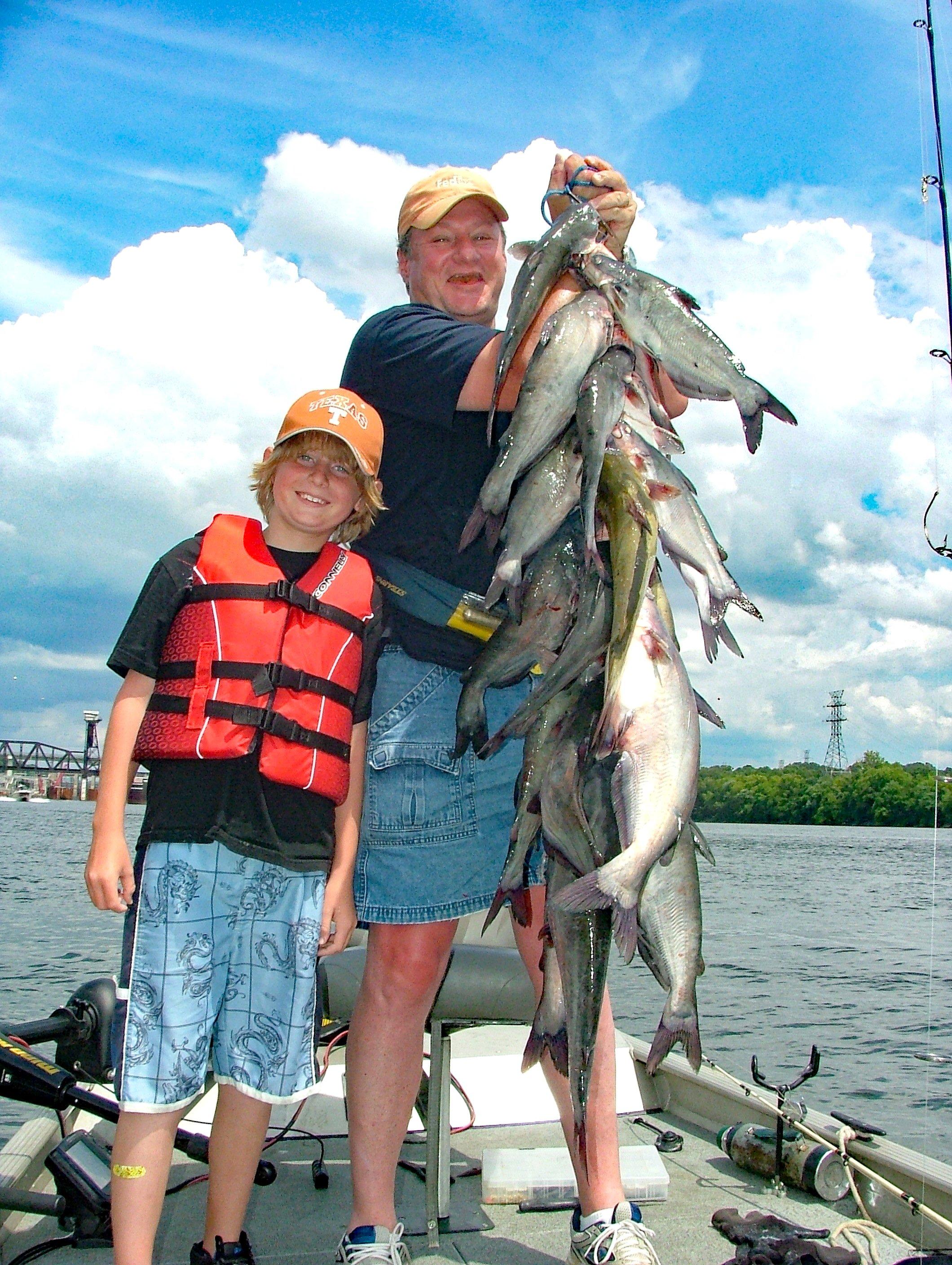
One of Capt. Simms’s longtime clients, Dan Griffith and his son, Josh, had lots of fun on this trip, and put lots of great catfish filets in the freezer. (Photo: Capt. Richard Simms)
DO YOU PREPARE THE CHICKEN A CERTAIN WAY?
I am routinely asked if I soak the chicken in some special concoction, flavor it with strawberry Jello or some of the other commercial scent products on the market. My answer is always a simple, “No.”
My chicken breast comes straight out of the grocery store packaging. It’s simple – big blue catfish want to eat one thing: dead meat.
Sure, most of the time their dead meat comes in the form of fish. But that definitely is not the only meat they will eat. They are opportunists and any dead meat that comes floating by will do. I’ve caught catfish on freezer-burned steaks, pork chops, and even the occasional duck breast.
I do believe the light color of chicken might help fish key in on it and I often wonder if it resembles clams or mussel meat that catfish often eat.
The real beauty of chicken breast is its density. Provided you trim all the fat off (if there is any), chicken breast sinks of its own accord.
The true secret of our light tackle drift technique is weight, or actually, the lack of weight. I always tell folks to "use the LEAST amount of weight possible." That includes sometimes using no weight. I prefer fishing with chunks of chicken cut roughly into the size of a ping pong ball or a golf ball. When fished on a slack line, the chicken breast is dense enough to slowly sink on its own.
I am firmly of the opinion that presentation matters, even to catfish, a great deal. A free drifting bait better imitates the food the catfish are used to seeing drifting along in the current.
The perfect analogy is a feather. When you drop a plain feather, it drifts and floats down naturally. Attach a split shot to it, however, and it simply plummets to earth and looks nothing like a feather. The same is true of your bait. The less weight attached, the more natural it looks floating or drifting in the water.
In our tailwaters, we cast the chicken breast directly upstream of the boat and drift at the exact same speed as the current. On a free drift with a slack line, the chicken sinks naturally. I've hung the bottom with weightless chicken as deep as 30 feet, as well as some huge catfish.
Don’t Miss: The 5 Best Live-Bait Rigs Made for Walleye Fishing
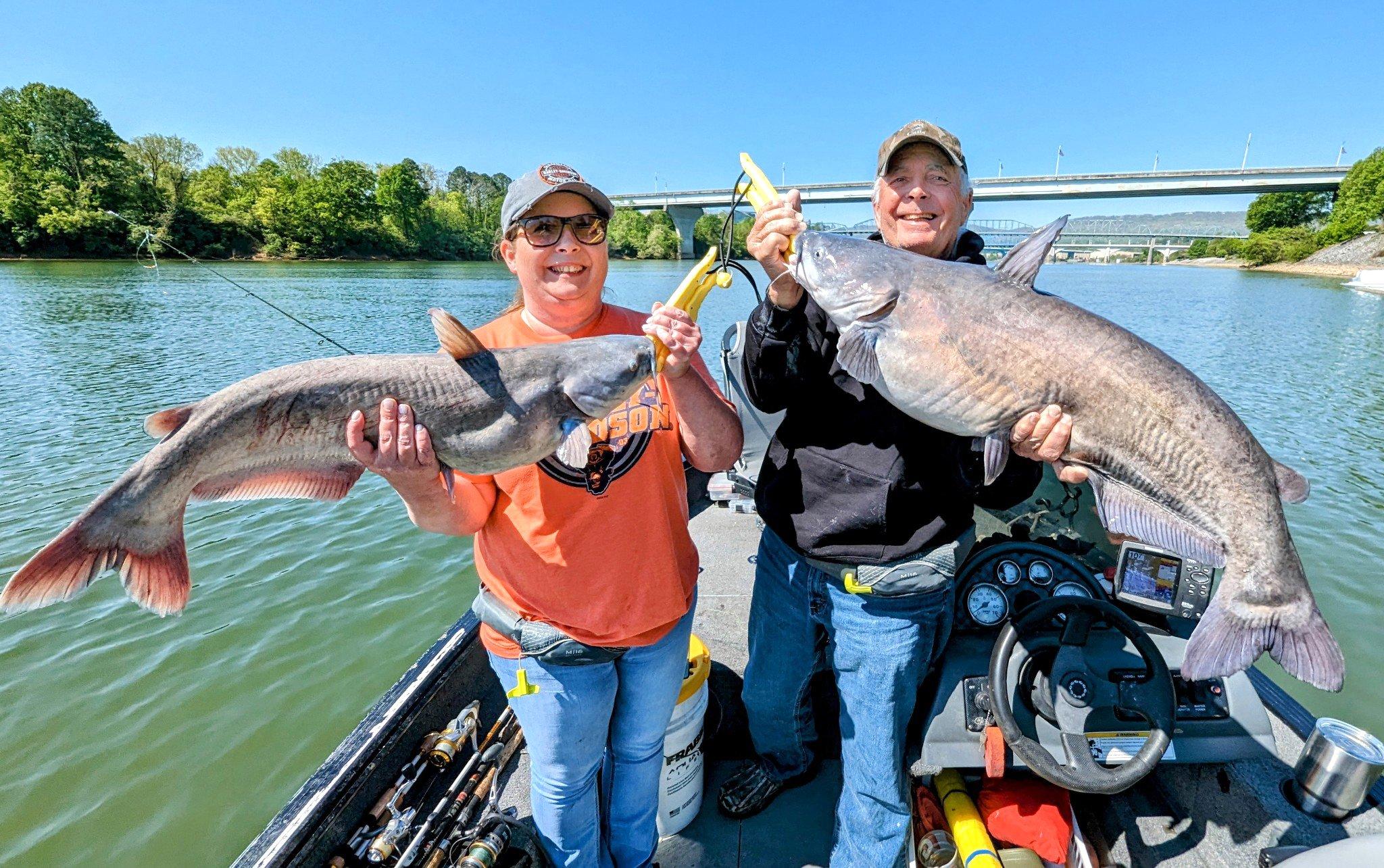
Jerry Madewell, a well-known outdoor journalist, and his daughter, Melissa, doubled up on big blues using the “chicken drift” technique. “I’ve fished a lot of different places and different ways, but this is a first for me,” Terry admitted. (Photo: Capt. Richard Simms)
BUT ISN’T IT EXPENSIVE?
Prices have increased, but I can usually get chicken breast for $2.99/pound at my area grocery store. On a 4-hour catfishing trip with two or three clients, I’ll typically use an average of 5 pounds of chicken. That’s about $15, an amount that will give or take depending upon how good or bad the fishing is, but call that an average.
That’s a lot of money, unless you calculate your man-hours spent catching your own bait. If you can buy skipjack from a retail bait shop, in our area it will cost as much as $5 per skipjack. But, the real beauty of chicken is that it NEVER goes to waste. Thawing and refreezing chicken liver is impossible. Every penny you spend on chicken livers for catfish bait is gone, whether you catch fish or not.
But if you don’t use all of your chicken breast on a fishing trip, you can refreeze it and thaw it multiple times and it works just as well. I like it fresh, but I’ve caught tons of catfish (literally, tons) on chicken that has been frozen and thawed.
Finally, chicken breast is tough and stays on the hook great. It is very rare to lose a piece of chicken, except when you actually catch the fish. And it is quite common to catch two or three decent-sized blues on a single chunk of chicken.
Of course, I also always tell clients (in jest), “I use chicken so, if I don’t catch any fish I can just go home and eat the bait.”
But one safety warning, keep your chicken cold. I have friends who have gotten some nasty infections on fingers or hands that were nicked or cut when they handled chicken that sat on the front deck too long. But in the 25 years I’ve been using chicken for catfish bait, it has never happened to me, primarily because I keep my bait iced down.
LIGHT TACKLE TECHNIQUE
The light tackle rig is exceedingly simple. Remember we are typically fishing the tailwaters of dams on the Tennessee River, usually drifting in a 1-2 mph current.
I used to always use 10-pound mono for my main line. My partners often still do. But I learned that 20-pound test braided main line is the same diameter as 10-pound mono, so I made the switch. I still use a 20-pound mono shock leader connected via a 2-way swivel. I still use the mono shock leader even with the braid because the mono withstands abrasions better and the swivel helps avoid line twist.
My preferred hook is a 3/0 Kahle-style from Boss Kat. The flat profile of this style hook hangs on the bottom less frequently than a standard J-hook. And as mentioned, we use the least weight possible, including no weight. The variable is based upon depth and the speed of your current. Too much current renders it ineffective (you would never want to try a light tackle drift on the Mississippi River).
In our tailwaters we cast it directly upstream of the boat and drift at the exact same speed as the current. Again, on the free drift on a slack line, the chicken sinks naturally.
The dealbreaker on using the technique can be a strong upstream wind that overpowers the boat free drifting in the current. If that happens, I will often point the boat downstream and strive to troll downstream against the wind at the exact speed of the current. It works, but it never works as well as a free drift.
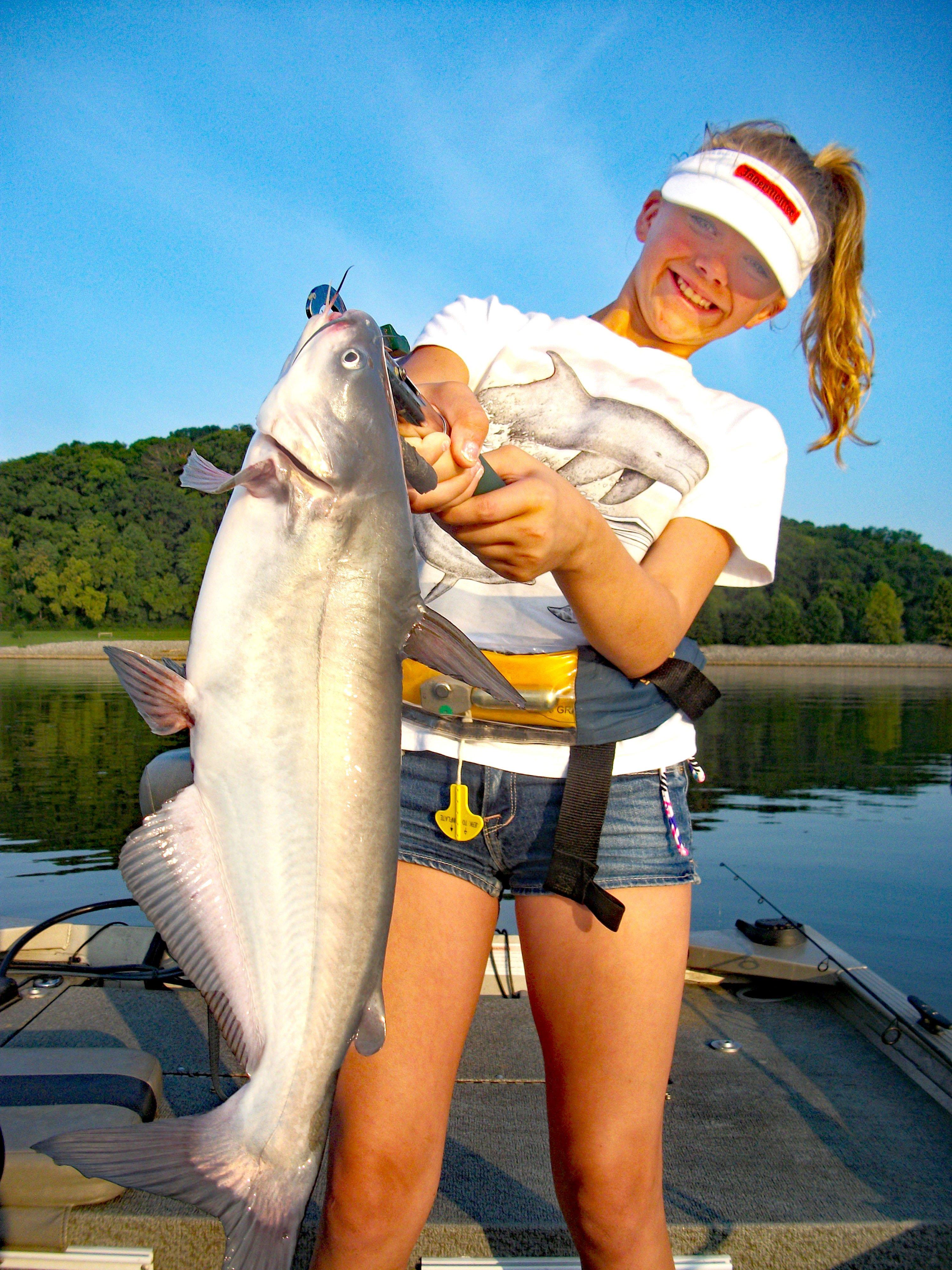
Fishing big, heavy tackle is wise for anglers specifically targeting trophy catfish. But when you just want to have lots of fun, keeping rods bent and people smiling, it is hard to beat light tackle fishing. (Photo: Capt. Richard Simms)
Why Not Heavier Line?
The principle of the light tackle technique is to provide a more natural bait presentation. Using heavier line or more weight greatly restricts the “floating feather” qualities of your bait drifting downstream. Without question, lighter, smaller diameter lines and less weight results in more bites.
When To Chicken Drift
The light tackle technique is not normally a cold weather technique. Our best light tackle bite typically begins in late-March or April and then continues throughout the warm weather months.
Sometimes the hotter it gets, the better the fishing. That, in part, is because TVA routinely needs to generate more power for air conditioners when it is hot and releases more water through the dams in the afternoons. More current often means more active fish.
Don’t Miss: Advanced Tips for Bass Fishing Boat Docks
Don’t Be Afraid to Size Down
Many catfishermen like catfishing specifically because they like pursuing monsters 50-pounds and up. Traditionally those folks use huge tackle. We do that as well.
However, those anglers might be missing out on a tremendous amount of action and fun. That is especially true if you are taking youngsters or inexperienced anglers that don't enjoy camping out for hours waiting on one "big fish bite."
There are times when sizing down your tackle might even be the best way to snag a monster. But in my humble opinion, it is always the best way to keep your rods bent and your friends (or clients) smiling.
From Chattanooga, Tenn., Capt. Richard Simms is owner of Scenic City Fishing Charters, Inc. He began his outdoor career as a Tennessee game warden later choosing journalism (and guiding) as his chosen profession. Check out his book, "An Outdoor State of Mind." You can contact him at [email protected].


